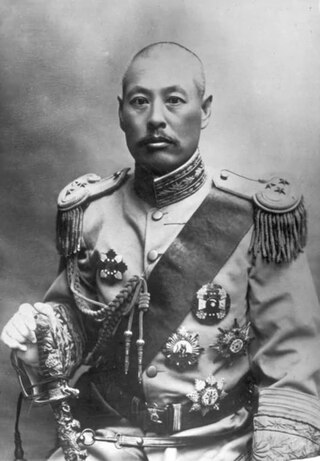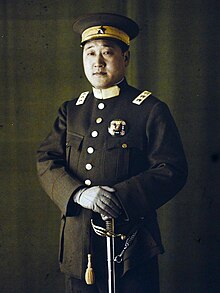
Feng Yuxiang, courtesy name Huanzhang (焕章), was a Chinese warlord and later general in the National Revolutionary Army. He served as Vice Premier of the Republic of China from 1928 to 1930.

The Beiyang Army, named after the Beiyang region, was a combined large army, Western-style Imperial Chinese Army established by the Qing dynasty government in the late 19th century. It was the centerpiece of a general reconstruction of Qing China's military system. The Beiyang Army played a major role in Chinese politics for at least three decades and arguably right up to 1949. It made the Xinhai Revolution of 1911 possible, and, by dividing into warlord factions known as the Beiyang Clique, ushered in a period of regional division.

Wu Peifu was a Chinese warlord and major figure in the Warlord Era in China from 1916 to 1927.

The Warlord Era was a period in the history of the Republic of China when control of the country was divided among former military cliques of the Beiyang Army and other regional factions from 1916 to 1928.

The Beiyang government was the internationally recognized government of the Republic of China between 1912 and 1928, based in Beijing. It was dominated by the generals of the Beiyang Army, giving it its name.

The Zhili clique was a military faction that split from the Republic of China's Beiyang Army of the during the country's Warlord Era. It was named for Zhili Province, which was the clique's base of power. At its height, it also controlled Jiangsu, Jiangxi, and Hubei.
The Anhui clique was a military and political organization, one of several mutually hostile cliques or factions that split from the Beiyang clique in the Republic of China's Warlord Era. It was named after Anhui province because several of its generals–including its founder, Duan Qirui–were born in Anhui.

The Fengtian clique was the faction that supported warlord Zhang Zuolin during China's Warlord Era. It took its name from Fengtian Province, which served as its original base of support. However, the clique quickly came to control all of the Three Northeastern Provinces. The clique received support from Japan in exchange for protecting Japanese military and economic interests in Manchuria. The Fengtian Army frequently intervened in many of the conflicts of the Warlord Era.
The Zhili–Anhui War was a 1920 conflict in the Republic of China between the Zhili and Anhui cliques for control of the Beiyang government.
The Second Zhili–Fengtian War of 1924 was a conflict between the Japanese-backed Fengtian clique based in Manchuria, and the more liberal Zhili clique controlling Beijing and backed by Anglo-American business interests. The war is considered the most significant in China's Warlord era, with the Beijing coup by Christian warlord Feng Yuxiang leading to the overall defeat of the Zhili clique. During the war the two cliques fought one large battle near Tianjin in October 1924, as well as a number of smaller skirmishes and sieges. Afterwards, both Feng and Zhang Zuolin, the latter being ruler of the Fengtian clique, appointed Duan Qirui as a figurehead prime minister. In south and central China, more liberal Chinese were dismayed by the Fengtian's advance and by the resulting power vacuum. A wave of protests followed. The war also distracted the northern warlords from the Soviet-backed Nationalists based in the southern province of Guangdong, allowing unhampered preparation for the Northern Expedition (1926–1928), which united China under the leadership of Chiang Kai-shek.
Events in the year 1924 in China.

The Beijing Coup was the October 1924 coup d'état by Feng Yuxiang against Chinese President Cao Kun, leader of the Zhili warlord faction. Feng called it the Capital Revolution. The coup occurred at a crucial moment in the Second Zhili–Fengtian War and allowed the pro-Japanese Fengtian clique to defeat the previously dominant Zhili clique. Followed by a brief period of liberalization under Huang Fu, this government was replaced on November 23, 1924, by a conservative, pro-Japanese government led by Duan Qirui. The coup alienated many liberal Chinese from the Beijing government.

The Anti-Fengtian War was the last major civil war within the Republic of China's northern Beiyang government prior to the Northern Expedition. It lasted from November 1925 to April 1926 and was waged by the Guominjun against the Fengtian clique and their Zhili clique allies. The war ended with the defeat of the Guominjun and the end of the provisional executive government. The war is also known as either Guominjun-Fengtian War, or the Third Zhili–Fengtian War.

Wu Guangxin, (simplified Chinese: 吴光新; traditional Chinese: 吳光新; pinyin: Wú Guāngxīn; Wade–Giles: Wu2 Kuang1-hsin1; IPA:[úku̯ɑ̄ŋɕīn]; 1881–1939) Army general of the Empire of Japan. Military and Civil governor of Hunan in 1920. Army Minister 1924–1925.
Hsu Dau-lin was a distinguished legal scholar who made substantial contributions to the study of Tang and Song Law and, especially for new republican states, of Constitutional Law. He devoted his prime years to the service of China as government official and as diplomat, and spent his later years teaching Chinese legal history in Taiwan, and Chinese literature and philosophy in America.

Duan Qirui was a Chinese warlord, politician and commander of the Beiyang Army who ruled as the effective dictator of northern China in the late 1910s. He was the Premier of the Republic of China on four occasions between 1913 and 1918, and from 1924 to 1926 he served as acting Chief Executive of the Republic of China in Beijing.
Lu Jianzhang was a general of the late Qing dynasty and early Republican period of China.

Xu is a Chinese-language surname. In the Wade-Giles system of romanization, it is spelled as "Hsu", which is commonly used in Taiwan or overseas Chinese communities. It is different from Xu, represented by a different character.

Qi Xieyuan, born Qi Ying, with a courtesy name of Qi Fuwan and the art name of Yaoshan, was a general of the military of the Republic of China and a warlord of the Zhili clique. He defected to the Japanese after the creation of the Provisional Government of the Republic of China, later participating in the North China Political Council, its successor.
The Tientsin Conference, beginning 10 November 1924, was a series of conferences between powerful Chinese warlords on the future government of China. It was hoped the result would be the reunification of the Beiyang government with the Kuomintang's rival government led by Sun Yat-sen in Canton and an end to the Warlord Era.














